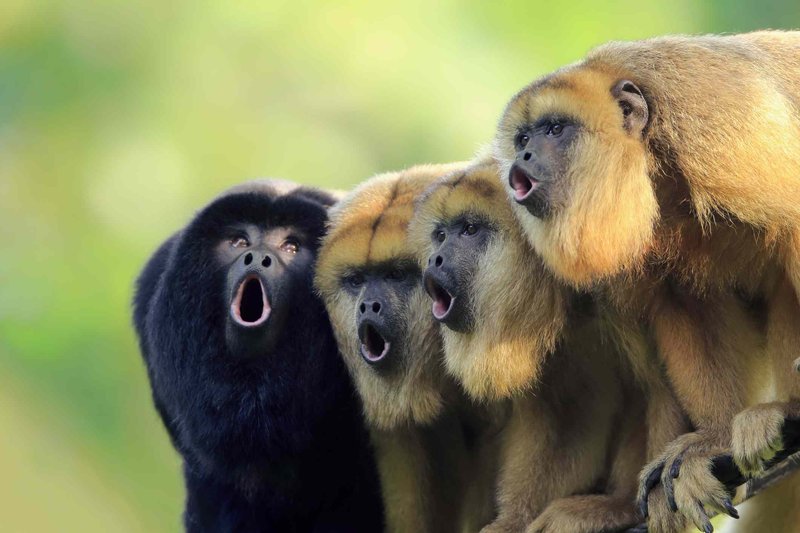
Howler monkeys are known for their distinctive, guttural howls, which can be heard from miles away. They’re often seen as symbols of the wild, vibrant life of the tropical rainforest. However, like many wild animals, their behavior can be unpredictable, and understanding their nature is key—especially if you encounter one in the wild. So, can they pose a danger to humans? The answer isn’t straightforward. Let me shed some light on this topic.
Understanding Howler Monkeys
Howler monkeys belong to the family Atelidae and are found primarily in Central and South America. They’re known for their loud vocalizations, especially the males, which can be heard up to three miles away. These monkeys typically live in troops, which can range from a few individuals to more than 20, depending on the species.
Visually, howler monkeys are quite striking. They come in various colors, including black, brown, and even red. Their long tails are prehensile, meaning they can grasp branches as they move through the forest. This adaptation makes them expert climbers and helps them navigate the challenging terrain of their rainforest homes.
You might be wondering how their behavior relates to danger. Howler monkeys are generally not aggressive, but like any wild animal, they can act defensively if they feel threatened. This is important to keep in mind when discussing interactions with humans.
When Do Howler Monkeys Become Aggressive?
Howler monkeys aren’t typically known for aggression, but there are moments when they can be. For example, if they feel their territory is being invaded or if a mother is protecting her young, they may show signs of aggression. This often involves loud vocalizations, displays of their teeth, or even charging at a perceived threat.
It’s essential to recognize that these behaviors are natural and instinctual. Howler monkeys are trying to assert dominance or protect their troop. For instance, if a tourist gets too close to a troop, it may result in a warning growl or howl. If the warning is ignored, the monkeys may escalate their behavior to defend themselves.
Another factor that can lead to aggression is stress. Habitat destruction and human encroachment can cause howler monkeys to feel cornered, leading to more aggressive behavior than usual. This is a reminder of the importance of respecting their space in the wild.
Risks of Howler Monkey Rabies
One of the more serious concerns regarding howler monkeys is the potential for rabies transmission. While the likelihood of encountering a rabid monkey is low, it is not impossible. Rabies is a viral disease that affects the brain and can be fatal.
If a howler monkey feels threatened or cornered, it may bite in self-defense. If that monkey carries rabies, the bite could pose serious health risks to humans. Symptoms of rabies in humans can take weeks to manifest, and by the time they do, it can be too late for effective treatment.
This doesn’t mean you should live in fear of howler monkeys, but it’s crucial to be cautious. If you ever find yourself in an area where howler monkeys roam, it’s best to admire them from a distance. That way, you can enjoy their beauty without putting yourself at risk.
How to Safely Observe Howler Monkeys
If you’re keen on observing howler monkeys, there are plenty of ways to do so safely. Here are some tips to ensure a positive experience:
- Keep Your Distance: Always maintain a safe distance from the monkeys. A good rule of thumb is to stay at least 50 feet away. This keeps both you and the monkeys safe.
- Avoid Feeding Them: Feeding wild animals is never a good practice. It changes their natural behaviors and might make them more aggressive toward humans.
- Stay Calm: If a howler monkey starts vocalizing or acting agitated, don’t panic. Calmly move away and give them their space.
- Observe Quietly: Loud noises can scare howler monkeys. Keep conversations to a minimum and enjoy the moment quietly.
By following these simple guidelines, you can enjoy watching howler monkeys without any unnecessary risks to yourself or the animals.
Comparing Howler Monkeys to Other Primates
When considering the danger posed by howler monkeys, it’s helpful to compare them to other primates. For instance, some primates, like capuchins, can be more aggressive due to their spirited nature and social structure. Capuchins are known for their intelligence and can even use tools, but they’re also more likely to come into conflict with humans, especially if they feel threatened or if food is involved.
In contrast, howler monkeys are generally more laid-back, primarily focusing on foraging for food and enjoying their time in the trees. They tend to be less confrontational, which is a big reason why many people see them as harmless.
That said, it’s important to treat all wild animals with respect and caution, as each species has its unique behaviors and potential risks.
So, can the howler monkey be dangerous to humans? The answer is nuanced. While they’re not typically aggressive and are fascinating to observe, they can display defensive behaviors when threatened. It’s crucial to respect their space and understand their behavior to minimize any risk.
Whether you see them swinging through the trees or hear their calls in the distance, howler monkeys are a reminder of the wild beauty of nature. Just remember, with a little caution and respect, you can safely enjoy their company without any danger. Next time you’re in a tropical rainforest, keep these tips in mind, and you’ll likely have an unforgettable experience!

